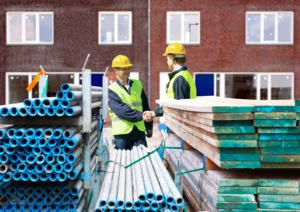From the shimmering skyscrapers that punctuate our city skylines to the cozy homes that cradle our families, construction projects form the foundation of our physical world. Behind each of these ventures is a complex network of industry professionals, among whom construction subcontractors hold a significant role.
Subcontractors – experts in specialized areas such as plumbing, electrical, carpentry, or painting – are often the unsung heroes of construction. They bring their unique skill sets to the table, alongside general contractors, playing a pivotal role in the successful completion of construction projects with their specialized knowledge and skills.
But effectively managing subcontractors is no small feat. Like the many moving parts in a precision timepiece, every subcontractor must be expertly coordinated to ensure the entire project runs smoothly. It involves navigating a maze of contract agreements, fostering communication, ensuring high-quality performance, meeting stringent safety regulations, and ultimately, building strong relationships that extend beyond individual projects.
In this article, we will delve deep into the realm of subcontractor management in construction, shedding light on the complexities and offering actionable strategies for project managers. Because when managed effectively, subcontractors can enhance project efficiency, improve quality, and contribute to successful, on-time project completion.
Whether you are a seasoned construction project manager, an industry professional, or a curious reader, join us on this insightful journey. Because understanding how to manage subcontractors in construction isn’t just an industry requirement – it’s a craft, honed through practice, patience, and a profound appreciation for the symbiotic relationships that bring our built environments to life.
Table of Contents
1. The need for subcontractor management in construction
When you gaze at a construction project underway, what you witness is a choreographed dance of workers, materials, and machinery. The scale can be awe-inspiring, but behind this spectacle lies a critical element that makes this dance possible – effective subcontractor management. Without it, this well-coordinated routine can quickly descend into a chaotic, costly, and potentially dangerous mess.
First and foremost, inefficient subcontractor management can escalate costs and cause significant project delays. Subcontractors perform a substantial portion of the work on construction sites, often as much as 80%. Unforeseen delays in one area can cause a domino effect, holding up other elements of the project, and in some cases, bringing the entire construction process to a grinding halt. And as any construction professional can attest, time delays invariably lead to cost overruns. It’s not just the financial implications; the reputational damage from a delayed or failed project can linger far longer than any immediate financial hit.
Another crucial aspect is the impact on project quality. Each subcontractor contributes specialized expertise to the overall project. However, without effective management and coordination, these discrete parts might not fit together as seamlessly as they should. The resulting inconsistencies can negatively affect the finished project’s quality and sustainability. Poor workmanship can lead to defects, subsequent repairs, and even potential structural issues, all of which could significantly devalue the project.
Beyond the operational considerations, there are also legal and safety implications tied to subcontractor management. In a field like construction, where safety is paramount, mismanaged subcontractors can increase the risk of accidents and non-compliance with health and safety regulations. This could lead to hefty penalties, legal action, and unfortunately, even loss of life. Hence, ensuring proper oversight of subcontractors is vital to creating a safe, compliant work environment.
In short, effective subcontractor management is not a luxury; it’s a necessity in construction. In the upcoming sections, we will unpack how to select the right subcontractors, establish expectations and clear contracts, foster efficient communication, monitor performance, ensure compliance, and build long-term relationships.
Remember, subcontractors are much more than just auxiliary entities; they’re vital contributors to your project’s success. Therefore, investing time and resources in their efficient management can pay rich dividends in the form of successful, high-quality, and safe construction projects. Embracing a comprehensive subcontractor management process, which includes a range of strategies and best practices, is crucial for successful project outcomes.
2. Selecting the right subcontractors
Finding the right subcontractor for your project is a bit like finding the perfect piece for a complex jigsaw puzzle. You want a piece that not only fits perfectly in its spot but also complements the surrounding pieces to create a harmonious whole. This section outlines the crucial process of selecting the right subcontractors, the first step to effective subcontractor management in construction.
Let’s begin by acknowledging that this process is far from easy. There are countless subcontracting firms in the market, each with its own strengths and weaknesses. The challenge is to sift through this sea of possibilities and identify the subcontractors who will deliver the highest quality work on time and within budget.
So, where to start? The cornerstone of a rigorous selection process is research. Delve into the history of potential subcontractors. Look at their past performance, paying particular attention to projects similar to yours. A subcontractor with a track record of successfully completing projects of a similar nature and scale is more likely to deliver the results you desire.
Yet, past performance isn’t the only factor worth considering. The subcontractor’s reputation in the industry can also be a valuable barometer of reliability. Reach out to their previous clients, read online reviews, and check for any complaints lodged against the subcontractor. A subcontractor with a strong reputation for integrity and professionalism is worth their weight in gold.
Another important criterion is financial stability. The last thing you want is for a subcontractor to go bankrupt mid-project, leaving you scrambling to find a replacement. You can ascertain a subcontractor’s financial stability by requesting financial statements, looking into their credit history, and ensuring they have a steady stream of projects.
In addition to these considerations, the selection process often includes a competitive bidding phase. This phase should not only consider the cost but also assess the subcontractor’s approach to the project, their understanding of the scope, their proposed timelines, and the quality of their work.
Finally, legal considerations should not be overlooked during the selection process. Ensure the subcontractor has the necessary licenses and insurance, and that they comply with all relevant regulations. It’s also worth consulting a lawyer to protect your interests and mitigate potential legal risks. Emphasizing the importance of a detailed subcontractor agreement is crucial, covering key components like scope of work, payment terms, and ensuring all commitments are documented to hold up in court.
Remember, selecting the right subcontractors isn’t a task to rush. Take your time, do your due diligence, and listen to your intuition. After all, these are the people you’ll be entrusting with a significant portion of your project. Make sure you choose a team that you’re confident will deliver top-notch work, on time and within budget.
3. Establishing Expectations and Clear Contracts
Imagine setting off on a journey without a clear destination or route. It’s easy to get lost, isn’t it? The same logic applies when you aim to manage subcontractors effectively. Without well-defined expectations and clear contracts, foundational for effective subcontractor management, your project can quickly veer off course, leading to misunderstandings, delays, and even disputes. This section will guide you through the process of establishing expectations and formulating clear contracts, setting the stage for a successful partnership with your subcontractors.
The foundation for a successful relationship with subcontractors lies in a clear scope of work. This includes detailed specifications about the work to be performed, the materials to be used, and the desired outcome. The scope of work should be so clear that there’s no room for interpretation or ambiguity. It serves as the blueprint that guides your subcontractors’ efforts, ensuring they know exactly what’s expected of them.
Setting performance standards and deadlines is equally crucial. Remember, your subcontractors may be experts in their respective fields, but they can’t read your mind. You need to communicate your expectations for the quality of work and timelines explicitly. It’s also helpful to establish milestones that mark progress towards the completion of the work. This keeps everyone on the same page and can help preempt delays or quality issues.
Payment terms are another critical aspect of your contract with subcontractors. Clearly outline when and how payments will be made. Are you going to pay in installments, upon completion of certain milestones, or upon the project’s final completion? Whatever your decision, make sure it’s clearly stated in the contract. Prompt payment not only helps maintain a positive relationship with your subcontractors but also ensures their commitment to your project.
Finally, the importance of legal advice during contract formulation cannot be overemphasized. Laws and regulations concerning construction contracts can be complex and vary by location. A lawyer can help you understand your obligations and protect your interests. They can help ensure that your contract is legally sound and contains provisions for resolving potential disputes or handling unexpected issues like scope changes or project delays.
Establishing clear expectations and drafting comprehensive contracts may seem like a daunting task, but it’s an investment that can save you a lot of headaches down the line. Remember, your goal isn’t just to get the job done; it’s to get the job done right. And that begins with ensuring your subcontractors know exactly what “done right” looks like.
4. Communication and Collaboration with Subcontractors
Let’s be honest; if you’ve ever played a game of ‘telephone,’ you know how quickly a message can get muddled as it passes from person to person. Now imagine this happening on a bustling construction site. It doesn’t paint a pretty picture, does it? Effective communication and collaboration are the lifeblood of any successful construction project, and this couldn’t be more true when managing subcontractors.
Effective communication begins with setting up robust channels that keep everyone informed and connected. These channels could range from regular on-site meetings and progress update emails to more sophisticated project management software. Regardless of the methods you choose, ensure that they are reliable, accessible, and capable of facilitating real-time communication.
Regular meetings and site visits play a pivotal role in this communication process. These gatherings provide a platform for you and your subcontractors to discuss progress, address issues, and recalibrate plans if necessary. These face-to-face interactions can help foster a spirit of teamwork and mutual respect. At the job site, effective communication and collaboration are crucial for managing subcontractors’ presence, ensuring safety measures are adhered to, tracking attendance, centralizing documents, and maintaining compliance with administrative processes.
In our technologically driven age, there’s a plethora of tools at our disposal to enhance communication and collaboration. From project management apps to virtual reality, these technologies can help streamline workflows, facilitate information sharing, and even allow you to visualize the finished project before the first brick is laid. Utilize these tools to foster a collaborative environment where everyone stays informed, aligned, and engaged.
Despite your best efforts, misunderstandings and disagreements can arise. How you handle these disputes can profoundly impact your project and your relationship with your subcontractors. It’s important to address issues promptly and fairly. Listen to your subcontractor’s concerns, engage in constructive dialogue, and work together to find a solution. Remember, the goal is not to win an argument but to move the project forward in a manner that’s satisfactory to all parties involved.
Communication and collaboration are not just about keeping the project on track; they’re about creating a positive work environment where everyone feels valued and heard. It’s about fostering relationships built on mutual respect and understanding. Because at the end of the day, a construction project isn’t just a physical structure; it’s a testament to the human relationships that helped shape it.
5. Monitoring and Evaluating Subcontractor Performance
The hustle and bustle of a construction site might seem chaotic to the untrained eye. But as industry professionals, we know that beneath this seemingly frenzied activity lies a well-oiled machine, where every move is deliberate and calculated. To keep this machine running smoothly, it’s essential to monitor and evaluate your subcontractors’ performance regularly.
Monitoring subcontractor performance starts with regular site visits. Walking the site enables you to observe the subcontractors’ work firsthand, gauge their progress, and assess the quality of their work. But remember, monitoring isn’t about breathing down your subcontractors’ necks. It’s about ensuring that they’re adhering to the project’s scope, maintaining quality standards, and working safely.
Regular check-ins with your subcontractors are also invaluable. These discussions offer an opportunity to gain insights into any challenges they might be facing and address any issues early on. They also allow you to provide constructive feedback and recognition, both of which can be powerful motivators.
Another important aspect of monitoring involves comparing the project’s progress with the original schedule. Are the subcontractors meeting the established milestones? If not, what’s causing the delay, and how can it be resolved? This comparison can help you stay ahead of any potential delays and adjust your plan if necessary. It’s crucial to regularly compare subcontractors’ progress against the project schedule to ensure timely completion and manage schedule conflicts effectively by aligning multiple contractors’ schedules within the overarching project plan.
Performance evaluation is a natural extension of monitoring. Regular evaluations help identify subcontractors who consistently meet or exceed expectations and those who fall short. Performance metrics can include quality of work, adherence to safety rules, on-time completion, cooperation, and many others. Document these evaluations as they can provide valuable insights when hiring subcontractors for future projects.
Technology can also aid in monitoring and evaluating performance. Project management software often includes features that allow you to track progress, maintain records, and generate reports. These tools can automate some of the tedious aspects of monitoring and leave you with more time to focus on managing the project.
Monitoring and evaluating subcontractor performance isn’t about playing ‘big brother.’ It’s about fostering an environment of accountability and continuous improvement. After all, the success of a construction project depends on every piece of the puzzle performing at its best.
6. Ensuring Compliance and Managing Risks
Construction sites can be risky places. The constant hum of machinery, the bustling movement of workers, the steady flow of materials – all these elements, while necessary for the job, carry inherent risks. Add to this the stringent industry regulations and you have a complex landscape that requires diligent oversight. Ensuring compliance and managing risks are therefore paramount in subcontractor management.
Ensuring compliance begins with a thorough understanding of the laws and regulations relevant to your project. These could pertain to building codes, environmental regulations, labor laws, health and safety standards, and more. Ignorance of these regulations is not an excuse for non-compliance and can lead to serious consequences including penalties, project delays, and damage to your reputation.
Next, these requirements must be communicated clearly to your subcontractors and enshrined in your contracts. But remember, having these stipulations on paper is not enough. Regular site inspections and audits should be conducted to confirm that these standards are being adhered to on the ground.
Safety compliance deserves special attention. With their in-depth knowledge, your subcontractors will play a critical role in identifying potential hazards related to their work. Foster an open dialogue about safety, encourage them to voice their concerns, and take prompt action to address these concerns. Safety training sessions and toolbox talks can also be helpful in maintaining a safety-conscious environment.
Risk management, on the other hand, involves identifying potential risks, assessing their impact, and developing strategies to mitigate them. These risks could range from project delays and cost overruns to accidents and quality issues. Involving your subcontractors in the risk assessment process can be beneficial as they can bring unique insights based on their expertise.
Once the risks have been identified, develop contingency plans to address them. These plans should outline the steps to be taken in the event of a risk materializing. This proactive approach can save precious time and resources when dealing with unforeseen issues.
In the realm of construction, compliance and risk management are not just boxes to be checked; they are integral to the project’s success and the wellbeing of all involved. When it comes to managing subcontractors, overlooking these elements can be a costly mistake. So be diligent, be proactive, and remember, safety and compliance are everyone’s responsibility.
7. Strategies for Building Long-term Relationships with Subcontractors
It’s said that Rome wasn’t built in a day, and neither are strong, enduring relationships with subcontractors. These relationships, built on trust, mutual respect, and shared success, can be a game-changer in the highly competitive construction industry. So, how do you cultivate these partnerships that stand the test of time? Here are a few strategies to help you on this journey.
Respect is the cornerstone of any strong relationship. Treat your subcontractors as valued partners rather than just hired help. This includes respecting their expertise, their time, and their contribution to the project. Make it a point to acknowledge their good work, and give credit where it’s due. This respect will not only foster goodwill but also motivate them to deliver their best.
Communication is another crucial element in building long-term relationships. Keep your subcontractors in the loop about project updates, changes, and future plans. Be open to their suggestions and feedback. In case of disagreements, engage in constructive dialogue to find a resolution.
Prompt payment can go a long way in building trust with your subcontractors. Late payments can strain your relationship and may even cause subcontractors to hesitate before taking on your future projects. So, honor your payment commitments and address any payment issues promptly.
Training and development opportunities can also strengthen your relationships with subcontractors. By investing in their skill development, you’re showing that you value their growth and are invested in their success. This could involve on-the-job training, workshops, or providing access to industry events and resources.
Last but not least, celebrate shared successes. When a project is completed successfully, it’s a testament to everyone’s hard work and dedication. Celebrate these wins with your subcontractors, and use these occasions to express your appreciation for their efforts.
Building long-term relationships with subcontractors is not a one-time effort, but a continuous process that requires patience, commitment, and genuine care. But the payoff – a pool of reliable subcontractors who are invested in your success – is well worth the effort.
Conclusion
Navigating the world of subcontractor management can feel akin to walking a tightrope at times. It’s a delicate balance between exercising control and fostering collaboration, between mitigating risks and enabling innovation, and between driving project success and building lasting relationships. But as challenging as it may seem, effective subcontractor management is a skill that can be honed, and the strategies outlined in this blog post can guide you on this journey.
Remember, the heart of subcontractor management lies in understanding that subcontractors are more than just a means to an end. They are your partners, each bringing their unique skills and expertise to the table. They are an extension of your team, working towards the same goal – to deliver a project that is a testament to quality, skill, and teamwork.
Invest time and effort in selecting the right subcontractors, establish clear contracts and expectations, maintain open lines of communication, monitor their performance diligently, ensure compliance, and most importantly, cultivate relationships that go beyond the current project.
In conclusion, successful subcontractor management isn’t just about getting the job done; it’s about how you get the job done. It’s about creating a work environment that values collaboration, encourages accountability, champions safety and quality, and nurtures long-term relationships. Because in the end, the success of a construction project is not just measured by the buildings erected, but by the bonds built along the way.
About the Author

Taavi Kaiv
Taavi Kaiv is a construction specialist with over ten years of experience in the construction industry. Taavi is an accomplished construction project manager with many successful projects that have been completed under his guidance. Taavi holds a master’s degree in construction management from the Tallinn University of Technology. View profile





